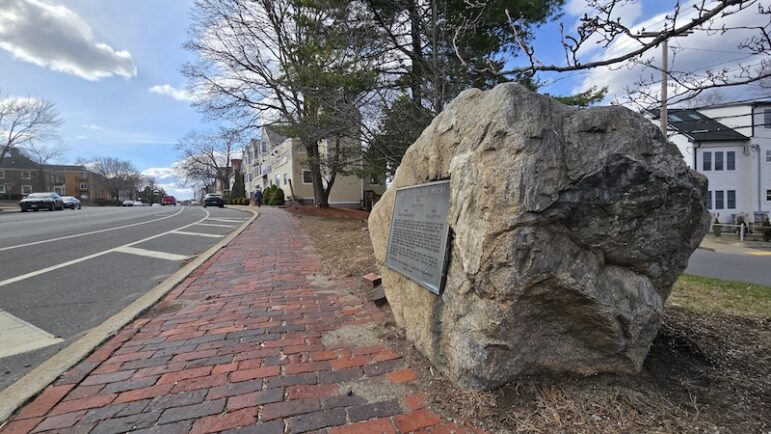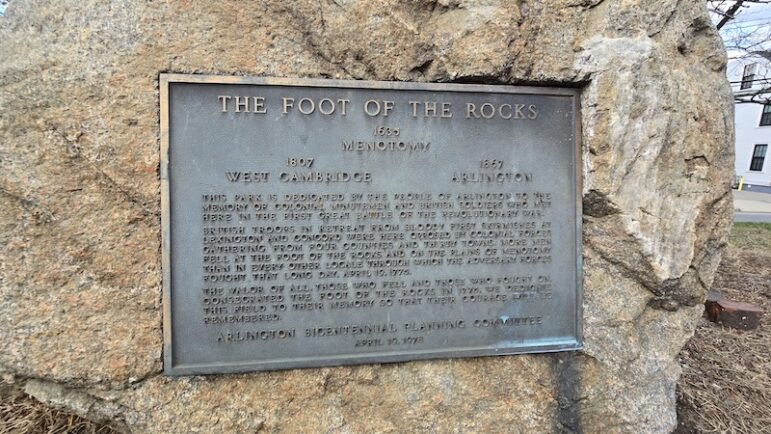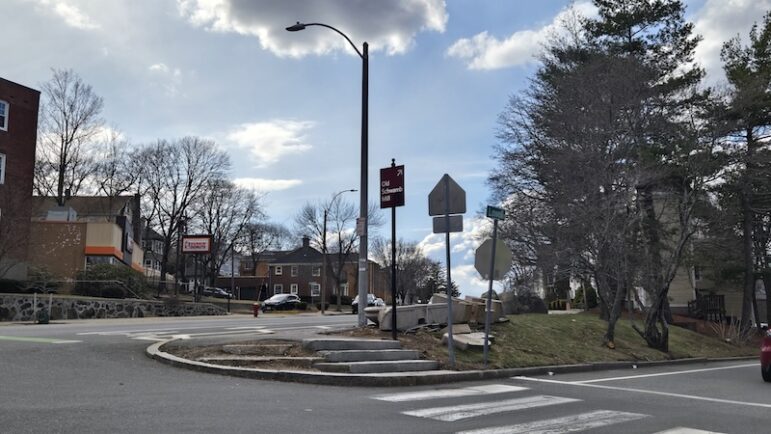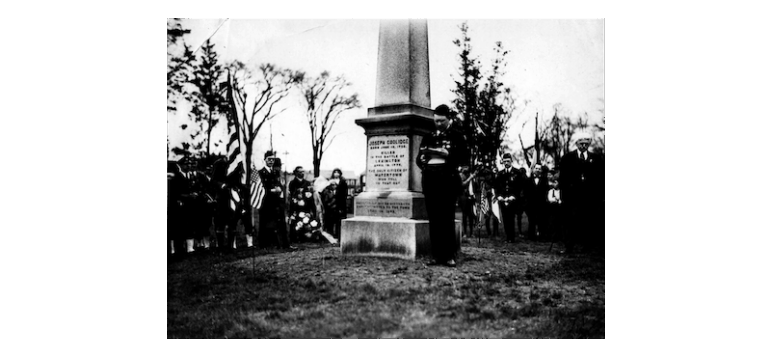
Two-hundred-fifty years ago was a turbulent time for Watertown. On April 19, 1775, more than 130 men from Watertown responded to the call to fight the British. They met the retreating Redcoats in what is now Arlington, exchanged fire, and one soldier from Watertown — Joseph Coolidge — was killed.
Saturday, April 19, 2025 marks the 250th anniversary of the beginning of the American Revolution, when the colonial militia faced the British Army at Lexington and Concord. Soldiers from Watertown took part in the aftermath of those battles, as the British Regulars made their way back to Boston.
Joyce Kelly of the Historical Society of Watertown said she recently learned where Watertown’s lone battle loss occurred.
“Joseph Coolidge was the only Watertown man killed that day,” Kelly said. “He died in Menotomy (now called Arlington) near the “Foot of the Rocks.”
A plaque now marks the location of the Foot of the Rocks, which sits at the fork of Massachusetts Avenue and Lowell Street and across the street from a Dunkin’ Donuts.
The spot is a good one for soldiers to take cover behind as Mass. Ave. curves and runs downhill as you head east. According to the Freedom’s Way website, “Here British soldiers retreating from Lexington and Concord were ambushed by colonial forces from four counties and thirty towns who lay in wait at what was the highest point along the road from Charlestown to Concord. It is recorded that more men fell at the Foot of the Rocks and on the plains of Menotomy than in every other locale through which the adversary forces fought on April 19, 1775.”

The plaque dedicated by the Arlington Bicentennial Planning Committee on April 19, 1978 reads:
“This park is dedicated by the people of Arlington to the memory of the Colonial Minutemen and British Soldiers who met here in the first great battle of the Revolutionary War.
British Troops in retreat from bloody first skirmishes at Lexington and Concord were here opposed by colonial forces gathering from counties and thirty towns. More men fell at the Foot of the Rocks and on the plains of Monotomy than in every other locale through which the adversary forces fought, that long day, April 19, 1775.
The valor of all those who fell and those who fought on, consecrated the Foot of the Rocks in 1775. We dedicate this field to their memory so that their courage will live on.“
Watertown’s Militia
In the lead up to the Revolution, Watertown’s militia began drilling for two hours each day for three months, and its stock of ammunition was inspected, according to “Watertown’s Military History,” published in 1907.
“The company was therefore in a fair condition of training the following spring,” the book reads.
On April 18, 1775, 800 British troops were sent from Boston to Concord to destroy stores of weapons, and seized John Hancock and Samuel Adams who were living in Lexington in the home of Rev. John Clark.
That day, Watertown’s Abraham Whitney was on his way by horseback to Lynn to deliver shoes for his brother. The book on Watertown history “Crossroad on the Charles” by Maud deLeigh Hodges, has the following account:
“On his way through Charlestown a man halted him, saying, ‘Do you know the regulars are landing?’ With the training and alertness of a minuteman and Son of Liberty, Whitney threw off his load, wheeled around, and galloped for home, where he had left his four children and their stepmother. On the way he gave the alarm, ‘The regulars have landed. Assemble on the church green at sunrise.'”
Coolidge was one of the 134 men to assemble that morning, according to “Crossroad on the Charles.”
“When the call to arms came to the Coolidge house on Grove Street, Coolidge left his plow, shouldered his gun, and volunteered to guide a Natick company to Lexington.”

Coolidge was one of Watertown’s tax collectors, according to “Crossroad on the Charles,” and when he went to join the militia that day, “his wife (Eunice) buried his tax records for safety.”
According to the book “Watertown’s Military History”: “Watertown took a creditable part in the work of that day. According to a historical sketch written by Solon F. Whitney, who for many years has been the town’s librarian, the Middlesex regiment, under command of Col. Thomas Gardner, assembled at the Watertown meeting house early on the morning of Apr. 19. In that regiment was the company of Watertown Minute Men, of which Captain Samuel Barnard was in command. This company had been formed in accordance with a vote of the town meeting.”

Troops from Newton, under the command of Michael Jackson, met up with Gardner’s regiment in Watertown.
“(Jackson) declared that the time for fighting had come, and he intended to have his company take the shortest possible route to get a shot at the British,” according to “Watertown’s Military History” “Each company choosing its course, the Watertown company hastened to Lexington. Near that town they joined the Newton company, and soon encountered Lord Percy’s retreating forces. They followed and harassed the enemy. Joseph Coolidge, of the Watertown company, was slain.”
“Crossroad on the Charles” includes the following account of that day.
“First to appear with his gun on that day was a twenty-year-old volunteer, Leonard Bond. Nineteen-year-old Nathaniel Bemis shouldered a musket marked with his father’s name, David Bemis, and the date, January 1775. He is said to have shot a retreating British officer and captured his sword, which the family kept as a memento for many years.”
The retreating British soldiers may have come through Watertown that day. “Crossroads on the Charles” includes the following account.
“A regiment of retreating redcoats found their way back through Watertown. One of them was passing near the house of Lydia Warren Barnard where a crowd had gathered. As local folklore has it, Mrs. Barnard seized his horse’s bridle and commanded him to dismount. He pleaded that he had done no shooting, but on opening his cartridge box she found several cartridges missing. She threatened him with his own sword till he fell on his knees and begged for his life. The story is told that bystanders took the captive to a tavern for safe keeping, and his horse was turned loose.”
The book also includes a footnote saying that “All accounts state that the line of retreat of the British was along Massachusetts Avenue until the neighborhood of Porter Square was reached. Watertown at that time did reach to Fresh Pond, about a mile from Massachusetts Avenue and it is possible that stragglers may have come that far from the main body, but hardly a regiment.”
The Coolidge Family
The Coolidges were early settlers of Watertown. The family owned a large amount of land in what is now East Watertown, a portion of which became part of Mount Auburn Cemetery, Kelly said. Joseph Coolidge’s farm house used to stand at what is now 662 Mt. Auburn St., at the corner of Grove street, according to “Crossroad on the Charles.”

After Coolidge’s death, “Crossroad on the Charles” reads: “His descendants honored him by erecting a seventeen-foot shaft over his grave in the old graveyard at the intersection of Arlington and Mt. Auburn streets.”
According to the book “The Descendants of John and Mary Coolidge of Watertown,” the town honored Coolidge 100 years after his death with a memorial in the Old Burying Ground.
The memorial reads: “Joseph Coolidge, born June 18, 1730. Killed in the battle at Lexington, April 19, 1775. The only citizen of Watertown who fell on that day.”
Kelly said Joseph Coolidge was a descendant of the first Coolidges, John and Mary.
“According to the book ‘The Descendants of John and Mary Coolidge of Watertown’ he was descended from their son Simon. And, according to the book, so was President Calvin Coolidge. His branch ended up moving to Vermont after the Revolution where the President was born,” she said.
President Coolidge came to Watertown in 1925 and visited the Old Burying Ground, where he visited his family’s graves.

Watertown Soldiers Who Responded to the Alarm
“Watertown’s Military History” includes a list of the company from Watertown who took part in the action that day. The book reads:
A Muster Roll of the company under the command of Capt. Samuel Barnard, in the late Col. Thomas Gardner’s Regiment of Militia, which marched on the alarm April 19, 1775:
Samuel Barnard, Capt.
John Stratton, Lieut.
Phinehas Stearns, 2nd Lieut.
Edwd Harrington, Ensign
Samuel Sanger, Sergt.
Christopher Grant, Sergt.
Josiah Capen, Sergt.
Stephen Whitney, Sergt.
Isaac Saunderson, Corp.
Moses Stone, Corp.
Nathan Bright, Corp.
Willm Harrington, Corp.
Nathan Coolidge
Nathan Benjamin
Stephen Cook
Josiah Saunderson
Seth Sanderson
John Sanger
Tilly Mead
Abraham Whitney
John Whitney
David Whitney
John Villa
Danl Mason
Willm Leathe
Thos Learned
Danl Collidge
Moses Collidge
Francis Brown
Isaac Prentice
Thomas Hastings
Amos Tainter
Josiah Norcross
Danl Whitney
Zacheriah Sheed
Jonathan Whitney
Spencer Gooding
Jona Coolidge Gooding
Thos Staftbrd
Edwd Harrington Sr.
Saml Sodin
David Capen
Saml White, Jr.
Jona Bright
Phinehas Childs
Jonas Bond, jr.
Richard Clark
John Remmington
Simon Coolidge, jr.
Jona Stone
Benja Capen
Bazaleel Larned
John Bullman
Willm White
Pennel Parks
Willm Jennison
Phinnehas Jenneson
Danl Learned
David Beamis, jr.
Jacob Saunderson
Jedediah Learned
Jonas Learned
Saml Bond
Moses Souter
Joel White
Willm Learned
Thos Prentice
Oliver Monroe
Ehiathan Whitney
Phinehas Harrington
John Cook
Willm Watson
John Randall
Jonas Coollidge
Elisha Tolman
Edmond Fowle
John Ciane
Stephen Harris
David Stone
Henry Gypson
Willm Chenery
Ephraim Jones
Richard Everitt
Willm Parks
Thos Coollidge
John Willington
John Fowle
Cornelius Stone
Peter Harrington
Jedediah Leithe
Saml Barnard, Jr.
David Parker
Danl Sawin, Jr.
Saml. Warrin
Joshna Stratton
Leonard Bond
Thos Clark
Peter Ricliardson
Saml White
Oliver Learned
John Chennery
Jona Benjamin
Danl Cook
Saml Warrin, jr.
Phinehas Childs, Jr.
Elijah Fiezie
John Hnnt, jr.
Will’m McCurtain
Amos Bond
Moses Hagar
Elias Tuffts
Elisha Brewer
James Austin
Jona Childs
Henry Bradshaw
Thos Hunt
Elkanah Wales
Simon Hastings
Benja Learned
Danl Jackson
Jonas White
Richard Loathe
Eben Everett
James Tufts
James Mallard
Ezekiel Whitney
Zechariah Hicks
Cornelius Parks
Nathl Harris, jr.
Willm Sanger
Saml Benjamin, jr.
Thos Wellington
Jonas Barnard, jr.
Converse Spring.
March 16, 1776. A true muster roll errors excepted.
That was interesting. I was told that my grandfather was a farmer and he worked at the Coolidge Farm
SO MANY OF THESE NAMES IN MY TREE – MARY COOLIDGE, JONAS BOND, NATHANIEL BRIGHT, JOSEPH MASON. MY TREE STARTS WITH HENRY BRIGHT AND
ANNA GOLDSTONE WHOSE SON NATHANIEL BRIGHT MARRIED MARY COOLIDGE.
Great research, Joyce! I had known some of this story, but not in the detail that you provide. I have occasion to go by that memorial a few times a month, and knowing that “our Watertown guys” took a stand on that day right there makes this space that hundreds of cars drive by daily more meaningful to me.
I think that you are in collaboration with the CPC to restore two of the burial grounds where many of our first patriots are buried? Thanks for your continued contributions to the appreciation of Watertown’s history, with all of the lessons that this provides for us today.
This is a fantastic article, thank you!
Great read! Thanks.